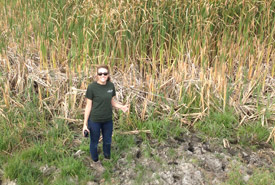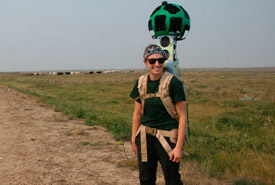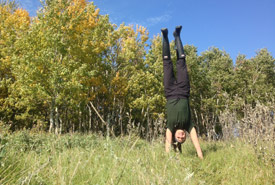Women in conservation: Carissa Sideroff

Carissa Sideroff working in the field. (Photo by NCC)
In honour of International Women’s Day (March 8), we’re celebrating eight female conservationists at the Nature Conservancy of Canada (NCC) who are working to create a stronger future for Canada’s landscapes.
In a small northern Alberta town lies a farm where a patch of tall trees line the fields, creating a perimeter of what once served as a fortress for Carissa Sideroff and her siblings. With plastic bread bags around their socked feet and lining their rubber boots, the Sideroff children spent their summer vacations on the farm, collecting colourful flowers and rocks to adorn their grandparents' farm-house porch. As the rock pile along the weathered railing grew, so did Carissa's passion for nature.
While she may live far from the farm now, her days of exploring Canada’s diverse lands are far from over.
Read my interview with Carissa below:
RB: What was your first job in the environmental/conservation/science field? What did you learn in this situation that has helped you now?
CS: My first job out of university was the job I am in now at NCC. I have learned so much over the past two years, working for a non-profit conservation organization, and it has really built my appreciation for undisturbed nature, whether it be a wetland, forest or Saskatchewan’s native prairie.
When you take the time to look around and appreciate all the little things, like a robin’s nest in a shrub with three little eggs about to hatch, nature is amazing. I think being out in the field has taught me to slow down and appreciate the little things.
RB: Describe a typical day at NCC for you.
CS: A typical work day in the field usually starts at around 6:00 a.m. It may start a little earlier if I’m staying in a one-and-a-half star hotel in rural Saskatchewan (I probably should have just slept in the truck). We usually travel in groups of two, or multiples of two if we have a big area to cover.

Carissa Sideroff capturing Old Man on His Back with the Google Trekker. (Photo by NCC)
Once we get out to the site, we begin to roam the property. If it is a conservation agreement property, we will walk around and take inventory on what species are present, compare the current state to what we had previously read in the baseline document and look to make sure the landowners are following the restrictions set out in the agreement. If NCC owns the property, we take an inventory and monitor any human or species activity.
Some days out in the field are longer than others; they range from eight to 15 hours, depending on what needs to be done on the property and how long we are in the area.
RB: Tell me about a time you consider to be your “best moment in science.” This could be a moment you discovered something in nature, a moment you saw a species or something you learned about yourself.
CS: My best moment in science is very hard to pinpoint, and probably will vary depending on what day you ask me. Today, I will talk about one of my favourite places I have been to during my career so far: Athabasca Falls, near Jasper, Alberta. If you‘ve been there, you will know what I’m talking about when I say it will make you appreciate the work Mother Nature puts in to create the beautiful landscapes we observe today.
It actually left me speechless to see what water could do to the surrounding rocks; the water was so persistent in creating the wonderful features that are forever engraved in my mind. You can see potholes created by the sheer forces of water carrying sediment. It also helps that there is a pretty mountain backdrop and the river is glacier fed, so the colour is awe-inspiring.
RB: Why is it important for women to be in science and conservation?
CS: Currently, women are underrepresented in the sciences. I think it is important for women to be in conservation, if that is what they love and what they want to pursue a career in. Women can empower other women or young girls to follow their dreams. Younger girls can be easily influenced, so if they talk to women in the conservation field or see more women in the sciences, maybe it will flick a switch in their heads and let them know that they can pursue a career in this field.
RB: What advice do you have for women looking to make a career in the sciences or, more specifically, the conservation field?
CS: I would say don't narrow your career path choices based upon circumstances in the field, and pick your career path based on your ability and interests. You could one day be the reason a little girl decided to follow her dreams and go into the sciences. We need to empower women, and we need girls to grow up and believe in themselves.

Carissa Sideroff (Photo by NCC)
More specifically, looking at the conservation field, I would say to girls to not be afraid to get their hands dirty. Speaking from experience, you may not always look Instagram-ready at work, but it's a very rewarding career choice. I think we need to start getting women to appreciate what the conservation field entails and how important it is.
There is only so much enjoyment you can get from sitting behind a computer and looking at pictures of nature. Get out there and go look at it for yourself. There is this feeling you get when looking at undisturbed native prairie. It just helps one realize that maybe it is the simpler things in life that bring true enjoyment and not the amount of material things you accumulate over the years. Money can’t buy experiences.
I think we need to make science cool again. I mean, I think science is cool.
If someone is looking to get into the conservation field I would tell them to get out in nature more. I feel like most people do not actually appreciate nature as much as they should, because they are not exposed to it. Start exposing young children to nature as soon as possible, and get them disconnected from their electronics so they too can appreciate nature.


